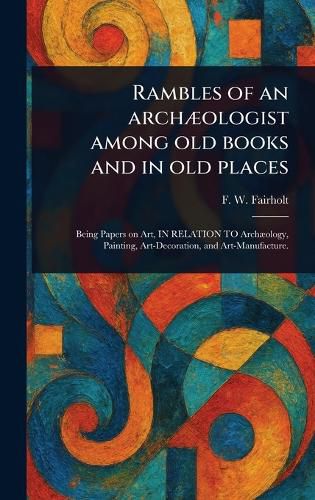Readings Newsletter
Become a Readings Member to make your shopping experience even easier.
Sign in or sign up for free!
You’re not far away from qualifying for FREE standard shipping within Australia
You’ve qualified for FREE standard shipping within Australia
The cart is loading…






This title is printed to order. This book may have been self-published. If so, we cannot guarantee the quality of the content. In the main most books will have gone through the editing process however some may not. We therefore suggest that you be aware of this before ordering this book. If in doubt check either the author or publisher’s details as we are unable to accept any returns unless they are faulty. Please contact us if you have any questions.
"Rambles of an Archaeologist Among Old Books and in Old Places" by Frederick William Fairholt offers a fascinating exploration of art and its connection to history. Subtitled "Being Papers on Art, in Relation to Archaeology, Painting, Art-Decoration and Art-Manufacture," this collection of essays delves into the intersections of art history, book history, and archaeology.
Fairholt, through insightful art criticism, examines various facets of artistic creation and preservation. The book includes a study of Albrecht Duerer, offering perspectives on his life and artistic contributions. Readers interested in the history of art, particularly painting and decorative arts, will find this a compelling resource. It explores the tangible links between artistry and the physical remnants of the past, making it a treasure for enthusiasts of antiques and collectibles.
This work has been selected by scholars as being culturally important, and is part of the knowledge base of civilization as we know it.
This work is in the public domain in the United States of America, and possibly other nations. Within the United States, you may freely copy and distribute this work, as no entity (individual or corporate) has a copyright on the body of the work.
Scholars believe, and we concur, that this work is important enough to be preserved, reproduced, and made generally available to the public. We appreciate your support of the preservation process, and thank you for being an important part of keeping this knowledge alive and relevant.
$9.00 standard shipping within Australia
FREE standard shipping within Australia for orders over $100.00
Express & International shipping calculated at checkout
This title is printed to order. This book may have been self-published. If so, we cannot guarantee the quality of the content. In the main most books will have gone through the editing process however some may not. We therefore suggest that you be aware of this before ordering this book. If in doubt check either the author or publisher’s details as we are unable to accept any returns unless they are faulty. Please contact us if you have any questions.
"Rambles of an Archaeologist Among Old Books and in Old Places" by Frederick William Fairholt offers a fascinating exploration of art and its connection to history. Subtitled "Being Papers on Art, in Relation to Archaeology, Painting, Art-Decoration and Art-Manufacture," this collection of essays delves into the intersections of art history, book history, and archaeology.
Fairholt, through insightful art criticism, examines various facets of artistic creation and preservation. The book includes a study of Albrecht Duerer, offering perspectives on his life and artistic contributions. Readers interested in the history of art, particularly painting and decorative arts, will find this a compelling resource. It explores the tangible links between artistry and the physical remnants of the past, making it a treasure for enthusiasts of antiques and collectibles.
This work has been selected by scholars as being culturally important, and is part of the knowledge base of civilization as we know it.
This work is in the public domain in the United States of America, and possibly other nations. Within the United States, you may freely copy and distribute this work, as no entity (individual or corporate) has a copyright on the body of the work.
Scholars believe, and we concur, that this work is important enough to be preserved, reproduced, and made generally available to the public. We appreciate your support of the preservation process, and thank you for being an important part of keeping this knowledge alive and relevant.